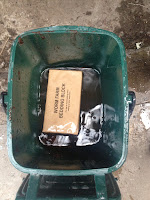The Tumbleweed Can of Worms has now been set up for a few days and i think that the worms have settled in nicely. A routine check on Friday night did alarm me slighty as lots of worms appeared to be recreating a scene from the Great Escape but apparently this is normal. Worms are a bit like barometers as they're sensitive to changes in atmospheric pressure and humidity. When it's raining, or looks iikely to rain, worms will often come up to the surface to move around freely, looking for food or even a mate so it's not unexpected and it's not a cause for concern! Thankfully, some nicer (dryer) weather on Saturday seemed to calm the little guys down so I set about making their first ever meal.The instruction booklet thst I received stated that they would eat pretty much any organic waste from the kitchen except meat and dairy and cooked food. Thats not to say that the worms won't eat it - but that they'll leave it until theres nothing nicer to eat and that can cause nasty smells and even encourage flies to lay eggs etc. Having listened to some vermicomposting experts, I decided to whizz my worm food up in a blender. The idea being that the more the food is chopped up, the greater the surface area. The greater the surface area, the more microbial activity. The more microbial activity, the quicker the conversion from food waste to vermicompost! Sounds great on paper....
 So, a whistle stop tour of the kitchen caddy revealed a couple of raw but slightly soft new potatoes and some dried up carrot batons. The dew bin in the fridge had a half used bag of mixed lettuce leaves and shredded beetroot that had just begun to go a bit soggy so it all got thrown into the food processor and was blitzed until it looked like this.
So, a whistle stop tour of the kitchen caddy revealed a couple of raw but slightly soft new potatoes and some dried up carrot batons. The dew bin in the fridge had a half used bag of mixed lettuce leaves and shredded beetroot that had just begun to go a bit soggy so it all got thrown into the food processor and was blitzed until it looked like this. 
 The other food waste products that are often mentioned are egg shells, cardboard tubes and tea bags. Egg shells provide worms with essential grit which they use in the same way as birds to break their food down in their gizzard. Egg shells can be thrown in to the worm farm intact but, as with all other food waste, the smaller the pieces - the quicker they can be used by the worms
The other food waste products that are often mentioned are egg shells, cardboard tubes and tea bags. Egg shells provide worms with essential grit which they use in the same way as birds to break their food down in their gizzard. Egg shells can be thrown in to the worm farm intact but, as with all other food waste, the smaller the pieces - the quicker they can be used by the worms
So, again following advice from other wormy websites, I baked the egg shells in a hot oven for 10 mins and then let them cool down before crushing them in a pestle and mortar.

The result is a fine powdery substance which can be added to the worm farm with their food.
I then added both the food......

...and the crushed eggshell to the worm farm to give my new worms their first ever meal!!!!
As this is their first meal, i'm not expecting the food to get eaten overnight. They're probably still settling in to their new surroundings and both the coir bedding and the cardboard packaging are edible meaning that the worms already have a good supply of nutritious food to eat. Still, i'll keep my eye on them and report back in a few days!
Happy worm farming everyone!
x

The result is a fine powdery substance which can be added to the worm farm with their food.

...and the crushed eggshell to the worm farm to give my new worms their first ever meal!!!!
As this is their first meal, i'm not expecting the food to get eaten overnight. They're probably still settling in to their new surroundings and both the coir bedding and the cardboard packaging are edible meaning that the worms already have a good supply of nutritious food to eat. Still, i'll keep my eye on them and report back in a few days!
Happy worm farming everyone!
x




















